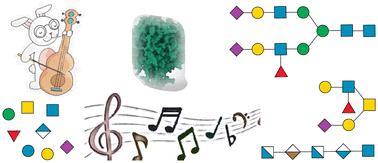Recent progress in chemoenzymatic synthesis of human glycans
IF 4.6
Q2 MATERIALS SCIENCE, BIOMATERIALS
引用次数: 0
Abstract
Glycan is an essential cell component that usually exists in either a free form or a glycoconjugated form. Glycosylation affects the regulatory function of glycoconjugates in health and disease development, indicating the key role of glycan in organisms. Because of the complexity and diversity of glycan structures, it is challenging to prepare structurally well-defined glycans, which hinders the investigation of biological functions at the molecular level. Chemoenzymatic synthesis is an attractive approach for preparing complex glycans, because it avoids tedious protecting group manipulations in chemical synthesis and ensures high regio- and stereo-selectivity of glucosides during glycan assembly. Herein, enzymes, such as glycosyltransferases (GTs) and glycosidases (GHs), and sugar donors involved in the chemoenzymatic synthesis of human glycans are initially discussed. Many state-of-the-art chemoenzymatic methodologies are subsequently displayed and summarized to illustrate the development of synthetic human glycans, for example, N- and O-linked glycans, human milk oligosaccharides, and glycosaminoglycans. Thus, we provide an overview of recent chemoenzymatic synthetic designs and applications for synthesizing complex human glycans, along with insights into the limitations and perspectives of the current methods.

人类聚糖化学合成的最新进展。
聚糖是一种重要的细胞成分,通常以游离形式或聚糖结合形式存在。糖基化影响着糖共轭物在健康和疾病发展中的调节功能,表明了聚糖在生物体中的关键作用。由于聚糖结构的复杂性和多样性,制备结构明确的聚糖具有挑战性,这阻碍了分子水平的生物功能研究。化学酶法合成是制备复杂聚糖的一种有吸引力的方法,因为它避免了化学合成中繁琐的保护基操作,并能确保聚糖组装过程中葡萄糖苷的高区域和立体选择性。本文初步讨论了糖基转移酶(GTs)和糖苷酶(GHs)等酶类以及参与人类聚糖化学合成的供糖体。随后展示并总结了许多最先进的化学酶方法,以说明合成人类聚糖(如 N 和 O 链接聚糖、人乳寡糖和糖胺聚糖)的发展情况。因此,我们概述了合成复杂人类聚糖的最新化学酶法合成设计和应用,并深入分析了当前方法的局限性和前景。
本文章由计算机程序翻译,如有差异,请以英文原文为准。
求助全文
约1分钟内获得全文
求助全文

 求助内容:
求助内容: 应助结果提醒方式:
应助结果提醒方式:


